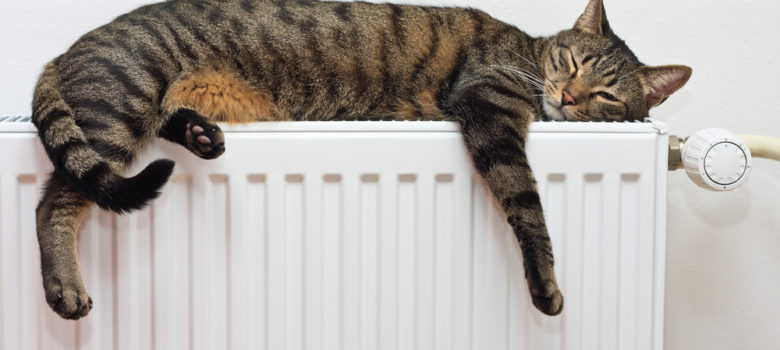
The chill is settling and winter is well on its way. Or as I like to call it, radiator and red wine season.
Conventional radiators work by conduction, cycling hot water through them thereby heating the metal it’s contained in. This heat is then transferred to the air in the room, and subsequently you. It’s all about getting heat from one source to another. It’s the most prevalent form of heat transference and it’s been used for heating homes with radiators for over 150 years.
The issue with this system is that it’s actually super inefficient. Energy is lost at each stage of the heat transfer, and that’s energy that you’re paying for. It’s therefore important to make the most of every little bit of heat possible.
Boiler Settings
If you have a traditional style central heating system, as most UK homes do, then your radiators are controlled by your boiler. You set the temperature the boiler heats the water to, which is then pumped through the radiators to heat them up. The key to saving energy here is not to set it higher than you need. A higher temperature will mean that your house warms up faster, but also that your bills will be higher.
Thermostat Settings
The thermostat is another control function you should very much keep your eye on. It’s a common misconception that your thermostat has some kind of control over the rate at which your house warms up. While the boiler controls the temperature to which your water is heated, the thermostat detects the overall temperature of the room/property and then communicates with your boiler to stop supplying hot water to the radiators when the correct temperature is reached.
If the temperature drops below the chosen level, the hot water will start flowing back into your radiators. Turning the thermostat up therefore won’t warm the home up faster, it will only keep the heating on longer to reach a higher overall level.
According to the UK government, guideline temperatures suggest 21c for your main living area and 19c for anywhere else. We think you could get away with a little lower, but the temperature is very much up you. The main thing to remember is that knowing your thermostat and setting it properly is the single most effective way to use your central heating.
Turning your thermostat down by just 1 degree can save the average household around £60 a year in fuel bills.
Thermostatic Radiator Valves
Thermostatic radiator valves (or TRV’s, for those of us with a fondness for acronyms) are one of the most fundamental and basic ways to control your heating and save money, but a lot of people just aren’t using them.
Think of the boiler as the central control unit, setting the temperature of the water that heats the radiators. What a thermostatic valve does is gives you individual control of each separate radiator. The dial allows you to choose the rate of flow at which the hot water moves through the radiator, which in turn determines much heat is transferred – the higher the dial, the faster the flow, the hotter the radiator.
This allows you to keep your living room warmer than your empty spare room, for example. It’s a good idea to make sure that your TRV’s are set properly; if the dial is down and the flow rate is low, less energy needs to be used to heat the water.
One thing to remember is that if you turn your TRV down in the room your main thermostat is located, the thermostat will read the temperature as low and mean that your heating stays on even once the rest of the house has warmed. Make sure you know exactly where your thermostat is located and that its readings are kept accurate.
Traditional TRV’s are simple, usually using a dial between 1-5 to set the rate, and you can pick them up for as little as £12.50, but there are also more high spec options. If you want full control of your heating system then smartphone enabled systems will give you the ability to zone out your house and only use the energy you need. This starter pack from tado provides everything you need to get set up with.
Insulation
The best way to use your heating, is to use it as little as possible. That’s why it’s massively important that your insulation is up to scratch:
- Loft insulation is the cheapest and easiest way to insulate your property and can often be done without the help of a professional installer.
- Cavity wall insulation can be applied for through government schemes and potentially installed for free.
- External wall insulation is more expensive, but is perfect for retrofitting to solid wall buildings.
- Double glazing will dramatically improve the thermal properties of your windows, but can be horribly expensive to retrofit. Secondary glazing is a better option for a lot of homeowners looking to cut back energy bills.
Radflek Radiator Reflectors
The biggest culprit for wasted energy in traditional radiators is that they are fixed to the wall. While it’s necessary for convenience, it’s also forcing a significant amount of heat into your walls as opposed to your home. The surface area at the back of the radiator is releasing heat which is being immediately absorbed by the wall behind it. As much as 40% of the radiator heat can be lost this way. Less than ideal.
Radflek is designed to stop this heat loss at the back of the radiator from happening. The specially treated sheets are composed of 7 separate layers and a polyethylene core, all working to create the perfect material to reflect the heat back in to the room. It’s been tested by the BBA (British Board of Agrément) and the findings verified by the BRE (Building Research Establishment), who certified it to have a lifespan of at least 60 years.
We’ve teamed up with the Radflek to offer our readers a 20% discount on all orders too, just use the offer code TGA20 at checkout to claim it. You’re welcome 🙂
Think we missed something? Do you have a different opinion?
Comment below to get your voice heard…












Radlfek is just posh kitchen foil…. Just saying…..
IF YOU HAVE RADS ON AN OUTSIDE WALL IT’S GOOD TO PREVENT YOUR HEATING THE OUTSIDE A BIT, AND JUST FOIL WON’T DO IT RIGHT, YOU NEED INSULATING FOAM ON THE BACK AND THE ADHESIVE TOO, TO STICK IT TO THE WALLS.
How can I tell the efficiency of my boiler? It’s 10 years old or so but I’ve been looking at new ones that can hit up to 96%!! I want to know what mine is so I can compare
https://www.homeheatingguide.co.uk/efficiency-tables?make=Potterton
Keith i found my boiler efficiency here.
Why cant someone tell me if I should set water temperature the same as heating temperature for more efficient use of an Ideal combi boiler
IF YOU HAVE KIDS THAT COULD GET SCOLDED BY HOT WATER I SUGGEST YOU SET THE WATER TEMP AS LOW AS YOU NEED, IF YOU RUN A BATH AND A CHILD FALLS IN IT COULD BE SERIOUS, WHERE AS IF THE TEMP IS LOW IT WON’T BE FATAL, PLUS IF YOU RUN TO WASH DISHES WHY HAVE TO ADD COLD WATER, JUST SET IT TO HOT ENOUGH,. MAKES SENSE TO ME, THEN YOU’RE NOT WASTING ENEERGY BY HAVING THE HOT WATER TOO HOT AND NEEDING TO COOL IT DOWN.
I went to an exhibition at excel for eco build where they had an additive to a central heating system that improved the thermal capability. Not a power flush , but I can’t see it anywhere on line, Are you aware of this chemical?
What temperature should I set the central heating part of my boiler to? I’ve seen as low as 50°C and as high as 70°C. It is a three-year old condensing boiler.
We have recently had an air source central heating system installed. However we have had no guidance of how to set the NIBE system and our daily electricosts (according to our Smart meter) is 3 times more than before this system was installed. Where can we get advice please – we have asked installers who keep promising to do something but seem to have no idea what to do.
IS IT BETTER TO KEEP A LOW TEMP ALL DAY AND NIGHT OR DO AS MOST SEEM TO DO AND HAVE THE HEATING ON MORNINGS AND EVENINGS ??